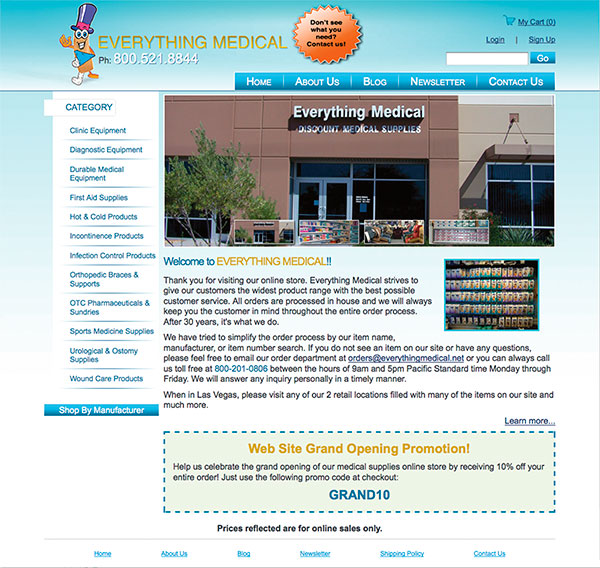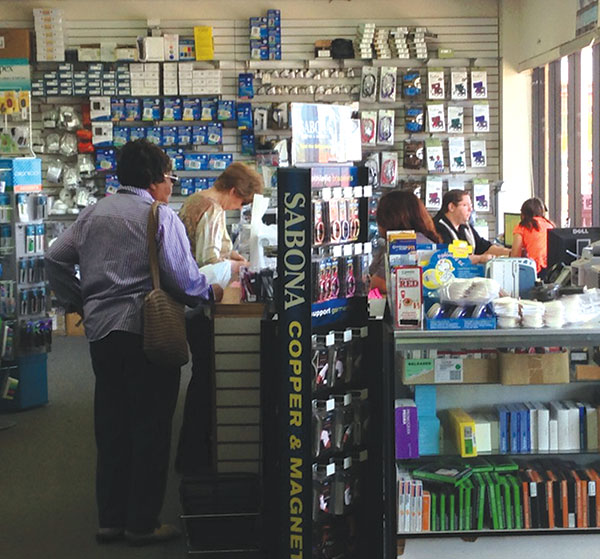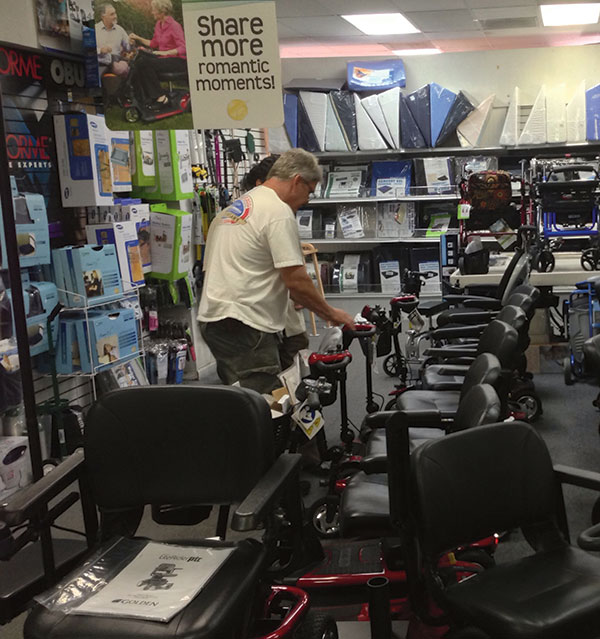For Jeffrey Kelemen of Everything Medical in Las Vegas, Nev., each day is a series of problem-solving tests. “What do I have to find, where can I get it and how can I take care of the customer?” he says. “That’s my puzzle of the day.”
Whether finding the perfect purple walker for a young woman with cerebral palsy or locating a decades-old product preferred by an ostomy patient, Kelemen delights in tracking down answers for his customers. In doing so, he knows he’s made a difference to someone’s quality of life. “There’s still this feeling that, at the end of the day, we’re in this business to help people. We’re not selling cars, we’re not selling cell phones.”
What he does sell is disposables and basic durable medical equipment. With the exception of some Medicaid and insurance business, all of the sales are cash sales. Everything Medical does not bill Medicare or HMOs, and it’s been that way since 1997. The company—which is owned by Kelemen and his father, Robert—is thriving, with two retail locations in Las Vegas, a 10,000 square-foot warehouse and an institutional supply business that sells medical products to schools, hotels and other organizations.
Everything Medical lives up to its name—it does business in 44 states and supplies a long roster of products: DME, clinic equipment, diagnostic equipment, first-aid supplies, hot and cold products, incontinence and infection control products, orthopedic braces and supports, over-the-counter pharmaceuticals and sundries, sports medicine supplies, wound care products and urological and ostomy supplies.
“I don’t do beds, I don’t do oxygen. But if you have a new diaper client, or a new wound care patient, those are the referrals I get,” says Kelemen, who snagged a prime location across the street from the University Medical Center.
He knows his company’s strengths and continues to build on them, but he’s also proud of its history.
Planting the Seed
In 1978 Kelemen’s father Robert, a pharmacist, and his mother Joanne, a teacher, started a little business in their garage in Los Angeles. It wasn’t home medical equipment. Instead, it sprang from the experience of Pearl Berman, Jeffrey Kelemen’s grandmother, who for many years had worked for the U.S. government in medical supply procurement. Berman believed there was a business opportunity to provide those supplies to school districts and governmental agencies.
So the Kelemens started United Health Supplies (UHS), which provided such products as bandages, cold packs and tape to school nurses’ offices. The business grew steadily as the Kelemens won bid contracts with various entities around the nation. Pearl Berman died in 1982, but the business continued to expand. UHS moved four times in five years during the 1980s because of its rapid growth, allowing Robert Kelemen to stop working as a pharmacist to focus on the burgeoning business. Then came the 1994 Northridge earthquake and the resulting flood that washed away the business. The Kelemens decided to move to Las Vegas, where they re-established UHS.
Jeffrey Kelemen was still in college at that time, majoring in business. He’d worked with his parents and also in retail stores. “When I got out of school, I said to my father, ‘I think we could do retail,’ so we opened up a little 900 square-foot store.”
That Las Vegas store offered wound care, first-aid supplies and walkers, and it was all retail. “I knew nothing about Medicare,” admits Kelemen, adding that he didn’t actually know much about DME either. But he knew enough about retail to build the business. Within five years of opening in 1997, the store had almost tripled in size.
Even so, Kelemen shied away from Medicare. He wasn’t tempted by the heavyweight product categories like oxygen and high-end wheelchairs. He preferred cash and began accepting some Medicaid as well. “I didn’t want to do Medicare, but we could handle Medicaid.”
In those days, Medicaid was technologically unsophisticated, which was fine with Kelemen. “Fifteen years ago Medicaid was within the scope of what I could handle,” he says. “They did hand billing, had their own codes, there was no HIPAA, no Centers for Medicare & Medicaid Services and no accreditation.”
As the program has become more sophisticated, Kelemen has managed to keep pace. “We’re high volume, but low tech,” he says, noting that a service company now handles his billing. He doesn’t utilize specialized business software, unless you count QuickBooks, but he says that an inventory tracking system is on the horizon.
“We run the business like a distribution center,” he says. Indeed, one of Everything Medical’s greatest assets is its large warehouse. “Our competitive advantage is that we can hold a big inventory,” which is something of an understatement since Everything Medical carries more than 25,000 SKUs.
“We’re always product oriented,” Kelemen says. “There’s nothing I can’t get. The only things I can’t buy are things that require prescriptions or that are regulated, like oxygen. People know if they can’t find it anywhere else, call Everything Medical.”
 Growing Up
Growing Up
As bright as the present is for Everything Medical, Kelemen isn’t resting on his laurels. In December the company launched a new website that targets both ends of the company’s core business—retail and institutional. The site is organized in a way that makes navigation easy for both novices and experts. Visitors can shop by clearly delineated categories such as first aid supplies, orthopedic braces and supports and infection control products. If a customer is seeking a particular brand, they can also search for products by vendor. There are approximately 100 listed, including 3M Health Care, Bayer, Brownmed, Covidien Healthcare, Graham-Field, Johnson & Johnson, Medline Industries, Stander, and many more. Kelemen anticipated immediate business from the institutional sector. “Ironically, a lot of our hits have come from Yellow Pages online, and they’re all local.”
He believes that will change over time as he adds to the site. He hasn’t, for example, promoted mobility products online yet. “I’m still working on how to handle the shipping,” he says.
Frankly, Kelemen likes to have control over his products. The warehouse allows him the ability to ship and receive, and thus maintain control over what is shipped, how it is shipped, freight costs and tracking. He could handle the shipping of mobility products from his warehouse, but does it make more sense, say, to have the manufacturer ship a lift chair? He’s still working on the answer to that one.
Meanwhile, Kelemen is also embarking on a redesign of the retail operations. While he wants to continue doing what works—“getting people the good products that they need”—he wants to do it better. “How do we handle retail better? It’s about presentation. It’s about educating the people who are selling it, the quality of the product itself and the reputation of the store behind it. That’s the only way I know how to move forward.”
To that end he plans to bring in experts from suppliers he has worked with for years, who know how best to display their products and generate interest. “The relationships we have with our vendors are going to help me do a good job redesigning the showroom,” he says. “I’m looking for the store to mirror what people want. How can we display a rollator better than on a platform and sticking a price tag on it?”
While he has no plans to expand the square footage at this point, he hopes the redesign will open up space for more products. He expects to add insurance plans to the roster of payers as well.
At the same time, he keeps a close eye on costs. “You can’t raise your prices anymore,” he says. “The Internet has already determined what the price is, so that’s all a customer is willing to pay. You’re capped on the retail end and you’re capped on the insurance end. The only way to make it is to cut your costs.”
Kelemen negotiates prices with the companies he works with, and the warehouse gives him an edge. If a manufacturer charges $150 to ship one lift chair, but waives shipping costs if you buy four, he can buy all four because he has a place to store them and he knows he can sell them all, likely within a week, he says.
With all the recent and upcoming changes, one thing will stay the same at Everything Medical: the care for the customer. “It takes just as much effort to frown as it does to smile,” Kelemen says. “Everybody feels welcome in here. I don’t want this to be a ‘sickroom store’ with everybody in lab coats. It’s always about how we can make their life better.”
Lessons Learned
Jeffrey Kelemen has learned some key business basics in his many years in the medical supply business. Among them:
“If it ain’t broke, don’t fix it. If someone is using a product and they are happy with it, don’t try to get them to use something else, even if they’re using an ostomy product from 48 years ago. It wastes your time and they probably won’t use it.”
Don’t go into product lines you don’t know. Kelemen subscribes to the idea that companies should focus on what they can do well, rather than take on products they know little about and aren’t equipped to handle. He works with local HME providers, referring customers to them for products he does not carry, such as hospital beds and oxygen. In turn, they refer customers to him for whatever they cannot provide.
Educate your employees. Send them to classes and bring in manufacturer reps for training. If they’re particularly interested in one area, bolster that with increased training and responsibility.
Learn more about Everything Medical by visiting www.everythingmedical.net.


